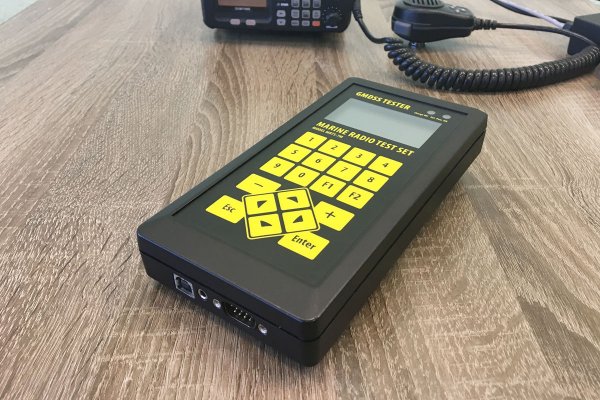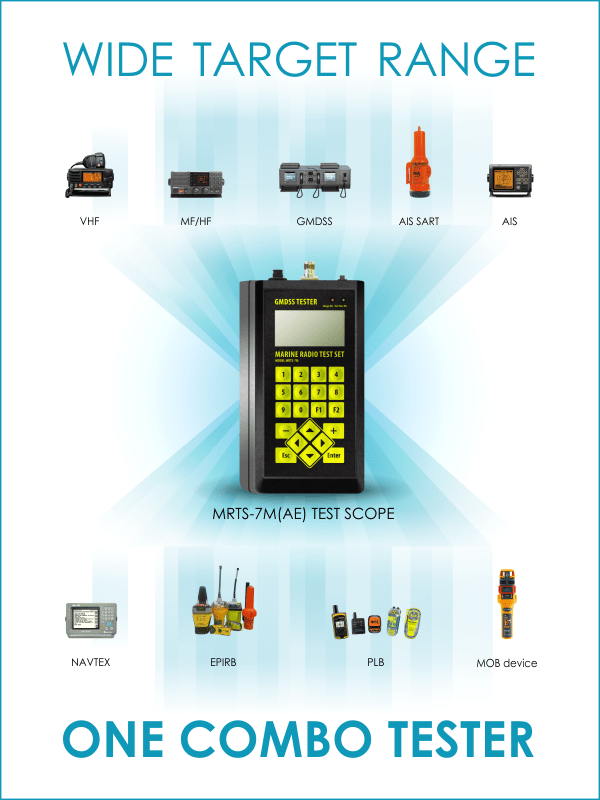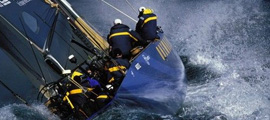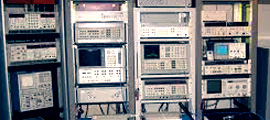GMDSS Tester MRTS-7M
Marine Radio Test Set MRTS-7M (GMDSS Multi Tester) is designed to carry out the mandatory periodical or annual surveys of all range of GMDSS equipment: AIS Stations, EPIRBs, MF/HF/VHF Radios with DSC and NAVTEX receivers in accordance with IMO A.948 (23) or A.997(25), A.1020(26), resolutions and MSC.1/Circ.1252, MSC.1/Circ.1039, 1040 circular letters.
Marine Radio Test Set MRTS-7M is all-in-one now.
The MRTS-7M is the device capable to provide accurate, independent operation test of the following equipment:
- VHF receiver-transmitters
- VHF DSC Controllers
- VHF Watch Receivers
- AIS Class A, AIS Class B, AtoN, AIS Base stations
- AIS-SARTs
- EPIRB, PLB
- MF/HF radiotelephone equipment
- MF/HF DSC Controllers
- MF/HF Watch Receivers
- NAVTEX equipment
- 9GHz SART (optionally)
The GMDSS Multi Tester MRTS-7M is specified equipment for radio inspectors performing mandatory, periodical surveys of ship-borne communication equipment.
The tester allows ensuring the GMDSS equipment meets the appropriate performance requirements.
The Marine Radio Test System MRTS-7M is capable to transmit and receive the signal by:
- broadcast antenna
- direct connection by means of power sensor meter, attenuator and cables (conductive measurements)
All the test procedures are provided in accordance with international standards, such as:
- IMO A.948 (23) or A.997(25), A.1020(26) resolutions (for marine radio stations);
- The circular letter MSC.1/Circ.1252 (for AIS stations);
- IMO Circular MSC.1/Circ.1039, 1040 (for C/S beacons);
- IMO Resolution A.802(19), SOLAS-74/88 (for SART).
The MRTS-7M has a newest software, designed to make survey work easier.
The device can be connected by means of standard USB A - USB B cable. Special software is available for download.
The software is compatible with Windows, MAC OS X and Linux. It provides possibility of automatic generation of IMO-like reports for all types of tested equipment. Even more, now a surveyor can generate one combined report of all the safety equipment tested on a vessel.
A surveyor’s paper work can be now reduced to minimum: just generate a report, print it and sign! Or save it and send by e-mail. Add your company header with the logo and contacts in the user's profile, thus the test reports will be automatically generated with the header selected.
Linux, OS X and Windows 10 don’t require any drivers installation. For Windows 7 and earlier versions FTDI driver should be installed for proper connection on first run.
Windows 32 bits is supported.
Complete set of the tester:
- Main unit (MRTS–7M)
- Power supply unit
- VHF/MF/HF telescopic antenna
- VHF Pow-VSWR meter (60W)
- USB-A – USB-B cable
- NMEA IN/OUT cable (DB9 fem – open wire 1.5m)
- User Manual
- Calibration Certificate
- Watertight & crushproof plastic box
OPTIONS:
- SART testing unit
- MF/HF Attenuator 200W
- AIS pilot-plug cable
Operational frequencies:
VHF range all simplex channels: 156,000-163,000 MHz
VHF range CH70: 156,525 MHz
MF/HF Range: 400 - 30 000 kHz
MF range DSC Mode:
- 2187.5 kHz – Distress frequency;
- 2177.0 kHz – Traffic frequency;
- 2189.5 kHz – Traffic frequency.
HF range DSC Mode:
- 4207.5 kHz
- 6312.0 kHz
- 8414.5 kHz
- 12577.0 kHz
- 16804.5 kHz
Measurement accuracy:
- Frequency measurement general: +/- 0.2 ppm +/-1 digit
- Frequency measurement at CH70: +/- 0.2kHz
Ouput signal:
Stability of output frequencies (GTXO-91V/EN 19.20MHz):
- Frequency setup accuracy at +25°С: ±1,0 ppm ;
- Temperature stability of frequency in range of 0 … +45°С: ±0,5 ppm ;
- Aging rate: not more ±1,0 ppm/year for first year.
Levels of output signals in DSC mode:
Max. POW level:
- VHF range: -13 dBm ± 1 dB;
- MF/HF range: -13 dBm ± 1 dB.
Min. POW level:
- VHF range: -99 dBm ± 3 dB;
- MF/HF range: -99 dBm ± 3 dB
Levels of output signals in MF/HF and VHF Synthesizer mode.
- 400 - 30 000 kHz: 13 dBm ± 1,0 dB
- 156 000 - 163 000 kHz: 13 dBm ± 1,0 dB
Signal attenuation range: 0 - 93 dB
Downloads
Other Products
AIS Tester
AIS Tester is a test device operating on AIS1 (ch87B), AIS2(ch88B) and DSC(ch70) frequencies. The tester is designed under corresponding standards and recommendations as a tool of operation and installation tests of AIS unit (Automatic Identification System). The tests’ volume complies with “Guidelines on annual testing of the AIS unit MSC.1/Circ.1252”.
GMDSS Tester MRTS-7 (discontinued)
MF/HF/VHF DSC Marine Radio Test System (MRTS-7) is designed to check the MF/HF/VHF stations with DSC by means of SENDING/RECEIVING of DSC messages on all allowed frequencies. Besides of that Test system can be used as frequency meter and HF oscillator.
406MHz BEACON Tester
406MHz SARSAT BEACON TESTER is designed to check the maritime emergency radio beacons operating via COSPAS-SARSAT system such as Emergency Position Indicating Radio Beacon (EPIRBs). Allows to perform annual testing according to requirements for shore-based maintenance under IMO Circular 10/40 and other resolutions requirements. Also allows fast check after beacon’s encoding or installation.
SART Tester (discontinued)
Device is discontinued and replaced by SART Tetser STU-1.
The SART Tester was designed for check of any SART in accordance with the requirements of SOLAS - 74/88, and the Russian Marine Register rules M.628-2. The SART Tester allows to measure the carrier frequency of response in range of 9140...9560MHz.
EPIRB Tester Mini
Easy testing of the maritime emergency radio beacons operating via COSPAS-SARSAT system. It is really portable. Wi-Fi supported. Use your mobile phone or tablet to check the beacons and make IMO test reports.
SART Tester STU-1
This PC-operated device enables accurate measurement of 9GHz SART's parameters and makes a conclusion whether the SART is operable according to the IMO Resolution A.802(19) and SOLAS - 74/88.
The STU-1 is very compact and lightweight test tool providing reliable check of any Radar-SART.
AIS Tester
GMDSS Tester MRTS-7 (discontinued)
406MHz BEACON Tester
SART Tester (discontinued)
EPIRB Tester Mini
SART Tester STU-1
SAFETY EQUIPMENT
AIS-SART, EPIRB, HRU G-5
Our company has developed completely new maritime safety equipment AIS-SART Musson - 502A, which operates in A and B VHF AIS channels.
Also we manufacture float Free Satellite Emergency Position Indicating Radio Beacon (EPIRB) under the IMO requirements for COSPAS-SARSAT system, a mandatory item in the GMDSS (Global Maritime Distress Safety System). Certified and type approved.
SPECIAL EQUIPMENT
406MHz BEACON Monitor, GALILEO REFERENCE BEACON GENERATOR BG-105/102, AIS Tester Pro Lab
We offer special equipment that mainly used by laboratories or manufacturers for quality control in production.
High accuracy professional 406MHz BEACON Tester BT-611M indended to check beacon compliance with the requirements, specified in C/S doc. T.001, T.007. AIS-SART Tester Pro Lab Tester is device used for verification of AIS and AIS-SART parameters in real time.
GALILEO REFERENCE BEACON GENERATOR BG-105/102r is high-precision simulator of Cospas-Sarsat emergency beacon messages.









